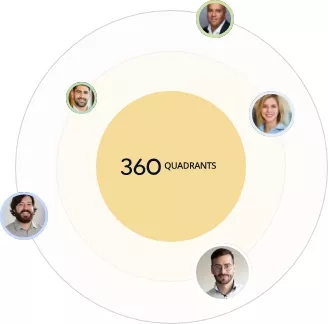Enterprise Content Management Software
Enterprise Content Management (ECM) can be defined as a process of accurately defining, sourcing, integrating, storing, and effectively retrieving and reconciling massive amounts of enterprise documents and making the right document available at the right time.
360Quadrants recognizes the below-listed companies as the best Enterprise Content Management Software
Top 10 Enterprise Content Management Softwares 2020:
- OPENTEXT
- IBM Corporation
- Hyland Software Inc
- Microsoft Corporation
- LASERFICHE
- Oracle Corporation
- M-Files Corporation
- Xerox Corporation
- Alfrensco Software Inc.
- Newgen Software Technologies Limited
The vendor evaluations are based on two broad categories - product offerings and business strategies. Each category carries various criteria, based on which the vendors are going to be evaluated. The evaluation criteria considered under product offerings include breadth of offering, delivery (based on industries that the vendors cater to, deployment models, and subscriptions), features/functionality, scalability, and support (based on pre- and post-sales support services). The evaluation criteria considered under business strategy include reach (on the basis of geographic presence), industry coverage (on the basis of end-users that the vendors cater to), roadmap, channel, viability, and inorganic growth (on the basis of partnerships, collaborations, and acquisitions).
OpenText, Oracle, IBM, Microsoft, and Hyland are the leading players in the Enterprise Content Management Software (ECM) market and are recognized as leaders. They have a strong portfolio of best Enterprise Content Management software or platforms, and associated services These vendors are making their presence felt by offering software that is required by most organizations. These vendors have a robust business strategy to achieve continued growth in the market.
Xerox, M-Files, and Newgen Software are recognized as dynamic differentiators. They have a strong business strategy with an extensive channel network and reach. Over the years, the dynamic vendors have been consistently generating positive revenue growth in the Enterprise Content Management software (ECM) market with their product offerings. Moreover, their market position is enhanced by organic and inorganic strategies undertaken by them over the period.
Laserfiche and Alfresco Software are recognized as innovators. They have a wide portfolio of ECM and the potential to build strong business strategies for their business growth to be on par with the leaders. These vendors have been providing top Enterprise Content Management software offerings as per their customer demands. Innovators have been at the forefront in deploying their solutions for the niche and custom software requirements of the clients.
Objective Corporation, Everteam, Unisys Corporation, BCS Software Inc, Intralinks Holidng Inc, Fabasoft, SAVO Group, Siav, Digitech Inc, R2 Sistemas, BlueprintECM Solutions, Inc, SER Group, SpringCM Corporation, Docstar (Epicor), Systemware, Inc. are recognized as emerging players in the Enterprise Content Management (ECM) market. The emerging players are specialized in offering highly niche and tailor-made solutions and services to their clients. These companies enable enterprises to not only build and manage content-driven processes, but also support new ways of working to drive business results.
The major Solutions Covered in ECM
Enterprise Content Management software (ECM) analyzed are content workflow, document management, imaging and capturing, web content management, records management, digital asset management, mobile content management, case management, and eDiscovery.
CONTENT WORKFLOW
Content workflow helps support various business processes and content routing. Enterprise content workflow management software automates business processes while sanctioning the efficient routing of files among employees and eliminating paperwork. Workflow solutions include functional process management solutions, which work within the ECM framework. Enterprise content workflow management tools are specially used for designing, modifying, personalizing, publishing, and managing the content generated within enterprises.
DOCUMENT MANAGEMENT
Large volumes of documents are generated within enterprises on a daily basis. This increases the need to manage and store the generated data. These days, the biggest challenge for enterprises is to digitize the documents and assemble them from different sources to provide a consistent view of enterprise data. The right information available at the right time from the right source can significantly improve the productivity of an organization.
IMAGING AND CAPTURING
Document imaging and capturing is a key process in the transformation and consolidation of documents. It creates a document repository and provides a uniform digitized view of the enterprise documents. Document imaging and capturing solutions are used to capture, store, and process various forms of enterprise content and deliver them in an electronic format to automate and control content-related processes. An organization’s ability to intelligently capture and manage documents determines how successful it will be at managing costs, delivering competitive products and services, and engaging with customers. Usually, documents form the core business area where large volumes of content are found. There is a growing need to modify, organize, and structure such content to seamlessly support scanning, imaging, and operations. Imaging and capturing solutions also help support content extraction, automatic indexing, and document handling. Centralized document storage, which ensures consistency, is crucial for maintaining the security of the electronic content. Moreover, enterprise document imaging and capturing solutions facilitate hassle-free retrieval of information from physical documents. Enterprise document imaging and capturing is crucial for maintaining an indexed location for the content and transforming print and data streams in proper readable outputs.
WEB CONTENT MANAGEMENT
The content generation has witnessed a significant increase due to rising internet consumption across the globe. The content generated in enterprises can be used to streamline business processes and reduce the overall cost of ownership. The increase in the number of eCommerce applications on a global scale has led to an increase in the need for content management. Web content management is a set of tools used by organizations to create, control, manage, and format web-based content. It is also known as online content management. The use of web content management helps organizations accurately manage content by allocating metadata for tracking. This ensures defined usage of web content and also links them with other assets in the repository. Web content management solutions automate and optimize the processes involved in web content production. They help enterprises enhance organizational efficiency and maintain a good stakeholder relationship by ensuring transparency and visibility.
RECORDS MANAGEMENT
Records management is essential because most enterprises are affected by mismanagement of records, including missing values, non-conformance to business semantics, repetitive records, and incorrect entries. Therefore, it is necessary for enterprises to put in place a proper records management framework to ensure business continuity. Enterprises across different sectors, such as BFSI, telecommunications, government, and healthcare, implement recordkeeping for various purposes. Records management is a cyclical process that enables continuous analysis, observation, and enhancement of enterprise records. Since most of the backend data is stored in databases in the format of a record, it is crucial to maintain data consistency and quality in records management.
DIGITAL ASSET MANAGEMENT
Digital asset management creates centralized storage for digital files and programs for archiving, retrieving, and searching for digital content. Digital asset management systems are a combination of software and professional services that provide a centralized repository for archiving, integrating, managing, and accessing digital assets, both documents, and their related metadata. Digital assets consist of images, graphics, logos, animations, audio/video clips, presentations, web pages, documents, and other digital file formats. Digital asset management is important for managing enterprise asset lifecycle. Digital content and metadata files are stored in separate databases; digital content is stored in the asset repositories, while metadata files, such as article keywords, contact names, photo captions, file names, low-resolution thumbnail images, and advertiser names, are stored in the media catalog database. Digital rights management solutions help catalog, search, modify, and retrieve assets for their permitted use.
MOBILE CONTENT MANAGEMENT
With the emergence of the Bring Your Own Device (BYOD) trend, the content generated by mobile devices is increasing at a faster rate. As the use of mobile devices is growing rapidly, it has become complex to handle mobile-generated content. Therefore, there is an increasing demand for mobile content management solutions. Mobile content management is a set of technologies capable of storing and providing secure content and services to various devices, such as smartphones, tablets, and Personal Digital Assistant (PDAs). Mobile content management helps enterprises store data on a centralized server in raw formats, and later these raw formatted data are delivered to various types of mobile devices in a device-compatible format. Mobile content management helps employees share, review, approve, write, read, edit, present, and perform countless work-oriented activities within seconds on their smartphones and tablets. Moreover, businesses consider mobile as a critical component of their digital marketing strategy and thus demand solutions that deliver optimized data.
CASE MANAGEMENT
Case management can be defined as the technique of processing a business case. A case refers to a collection of files, digital documents, and business workflow activities by knowledge workers or caseworkers. A case can be defined as a business entity that an organization possesses and which needs to be processed. Case management provides an intelligent and smart way of dealing with shrinking resources and growing business caseloads. Case management solutions are considerably important for managing enterprise content, tasks, processes, and services. They enhance the business productivity and efficiency of an enterprise.
eDISCOVERY
eDiscovery can be defined as the process of identifying, collecting, and producing Electronically Stored Information (ESI) for particular civil litigation or investigation. ESI can be documents, emails, databases, voicemails, presentations, audio and video files, websites, or social media data. eDiscovery solutions include solutions for legal hold (legal hold prevents addition, modification, and deletion of data), early case assessment, data processing, and data production. These solutions and services help users to store electronic information that can be used as digital evidence in litigation issues. This information is also vital for enhancing the security of electronic documents and ensuring enhanced organizational e-governance performance. eDiscovery technologies and processes are complex due to the large volumes of the generated electronic data. eDiscovery is mainly used when court litigation or investigation affects the business processes.


